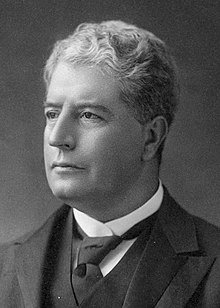
Back إدموند بارتون Arabic إدموند بارتون ARY ادموند بارتون ARZ Edmund Barton AST Эдмунд Бартан Byelorussian Эдмунд Бартан BE-X-OLD Edmund Barton Catalan Edmund Barton Czech Edmund Barton Danish Edmund Barton German
Sir Edmund Barton | |||||||||||||||||||||||||||||||||||||||||||||||||||||||||||
|---|---|---|---|---|---|---|---|---|---|---|---|---|---|---|---|---|---|---|---|---|---|---|---|---|---|---|---|---|---|---|---|---|---|---|---|---|---|---|---|---|---|---|---|---|---|---|---|---|---|---|---|---|---|---|---|---|---|---|---|
 Barton in 1902 | |||||||||||||||||||||||||||||||||||||||||||||||||||||||||||
| 1st Prime Minister of Australia | |||||||||||||||||||||||||||||||||||||||||||||||||||||||||||
| In office 1 January 1901 – 24 September 1903 | |||||||||||||||||||||||||||||||||||||||||||||||||||||||||||
| Monarchs | Victoria Edward VII | ||||||||||||||||||||||||||||||||||||||||||||||||||||||||||
| Governors‑General | Lord Hopetoun Lord Tennyson | ||||||||||||||||||||||||||||||||||||||||||||||||||||||||||
| Preceded by | Office established | ||||||||||||||||||||||||||||||||||||||||||||||||||||||||||
| Succeeded by | Alfred Deakin | ||||||||||||||||||||||||||||||||||||||||||||||||||||||||||
| Justice of the High Court of Australia | |||||||||||||||||||||||||||||||||||||||||||||||||||||||||||
| In office 5 October 1903 – 7 January 1920 | |||||||||||||||||||||||||||||||||||||||||||||||||||||||||||
| Nominated by | Alfred Deakin | ||||||||||||||||||||||||||||||||||||||||||||||||||||||||||
| Appointed by | Lord Tennyson | ||||||||||||||||||||||||||||||||||||||||||||||||||||||||||
| Preceded by | Office established | ||||||||||||||||||||||||||||||||||||||||||||||||||||||||||
| Succeeded by | Hayden Starke | ||||||||||||||||||||||||||||||||||||||||||||||||||||||||||
| |||||||||||||||||||||||||||||||||||||||||||||||||||||||||||
| |||||||||||||||||||||||||||||||||||||||||||||||||||||||||||
| Personal details | |||||||||||||||||||||||||||||||||||||||||||||||||||||||||||
| Born | 18 January 1849 (now New South Wales, Australia) | ||||||||||||||||||||||||||||||||||||||||||||||||||||||||||
| Died | 7 January 1920 (aged 70) Hydro Majestic Hotel, Medlow Bath, New South Wales, Australia | ||||||||||||||||||||||||||||||||||||||||||||||||||||||||||
| Resting place | Waverley Cemetery | ||||||||||||||||||||||||||||||||||||||||||||||||||||||||||
| Political party | Protectionist (after 1887) | ||||||||||||||||||||||||||||||||||||||||||||||||||||||||||
| Spouse | |||||||||||||||||||||||||||||||||||||||||||||||||||||||||||
| Children | 6 | ||||||||||||||||||||||||||||||||||||||||||||||||||||||||||
| Education | |||||||||||||||||||||||||||||||||||||||||||||||||||||||||||
| Alma mater | University of Sydney | ||||||||||||||||||||||||||||||||||||||||||||||||||||||||||
| Profession | Barrister Politician | ||||||||||||||||||||||||||||||||||||||||||||||||||||||||||
| Signature | |||||||||||||||||||||||||||||||||||||||||||||||||||||||||||
| ||
|---|---|---|
Term of government (1901–1903)
Justice of the High Court of Australia (1903–1920) |
||
Sir Edmund "Toby" Barton GCMG KC (18 January 1849 – 7 January 1920) was an Australian statesman, barrister and jurist who served as the first prime minister of Australia from 1901 to 1903. He held office as the leader of the Protectionist Party, before resigning in 1903 to become a founding member of the High Court of Australia, on which he served until his death. He was highly regarded as one of the leaders and founding fathers of the Federation movement and for his work in drafting and later interpreting the Constitution of Australia and early federal laws.
Barton was an early supporter of the federation of the Australian colonies, the goal of which he summarised as "a nation for a continent, and a continent for a nation". After the retirement of Henry Parkes he came to be seen as the leader of the federation movement in New South Wales. He was a delegate to the constitutional conventions, playing a key role in the drafting of a national constitution, and was one of the lead campaigners for federation in the subsequent referendums. In late 1900, despite the initial "Hopetoun Blunder", Barton was commissioned to form a caretaker government as Australia's first prime minister. His term began on 1 January 1901, the date on which federation occurred.
At the first federal election in March 1901, Barton and the Protectionists won the most seats, but were well short of a majority. He was able to remain as prime minister by forming an alliance with the fledgling Australian Labor Party (ALP), which held the balance of power. The Barton government established a number of new national institutions, including the Australian Defence Force and the Commonwealth Public Service. It introduced nation-wide women's suffrage, and laid the foundations of the White Australia policy with the Immigration Restriction Act 1901.
Barton left politics in 1903 to become one of the three founding members of the High Court, which his government had created. He was succeeded as prime minister by Alfred Deakin. On the court, Barton was able to shape the judicial interpretation of the constitution he had helped write.
© MMXXIII Rich X Search. We shall prevail. All rights reserved. Rich X Search
